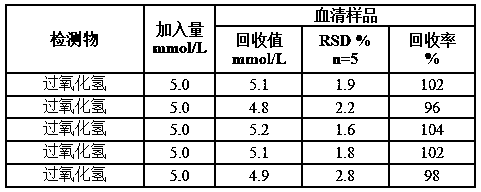Preparation method and application of a hydrogen peroxide photoelectrochemical sensor based on self-luminescence excitation
A self-luminous excitation, hydrogen peroxide technology, applied in chemiluminescence/bioluminescence, analysis through chemical reactions of materials, electrochemical variables of materials, etc., can solve the problems that affect the convenience of operation and limit the wide range of applications , to achieve the effects of convenient operation, high selectivity detection, and broad market application value
- Summary
- Abstract
- Description
- Claims
- Application Information
AI Technical Summary
Problems solved by technology
Method used
Image
Examples
Embodiment 1
[0036] Example 1 A hydrogen peroxide photoelectrochemical sensor based on self-luminous excitation
[0037] A method for preparing a hydrogen peroxide photoelectrochemical sensor based on self-luminescence excitation, the specific preparation steps are:
[0038] (1) Preparation of electrochemiluminescent working electrode W1:
[0039] 1) Use ITO conductive glass as the working electrode, and drop-coat NH on the surface of the electrode 4 NiPO4 , covering an area of 1 cm × 1 cm, dry at room temperature;
[0040] 2) Immerse the working electrode obtained in 1) into the electrolyte solution, and the immersion area is NH 4 NiPO 4 The covered area was electrochemically deposited on the working electrode using a three-electrode system. After deposition, the working electrode was taken out, washed with ultrapure water, and dried at 4 °C in the dark to prepare the electrochemiluminescence working electrode W1;
[0041] The NH 4 NiPO 4 The solution is an aqueous solution of nic...
Embodiment 2
[0058] Example 2 A hydrogen peroxide photoelectrochemical sensor based on self-luminous excitation
[0059] A method for preparing a hydrogen peroxide photoelectrochemical sensor based on self-luminescence excitation, the specific preparation steps are:
[0060] (1) Preparation of electrochemiluminescence working electrode W1:
[0061] The preparation steps are the same as the preparation steps of W1 in Example 1, the difference is: the ammonium salt addition is 0.3 g in the preparation step of the nickel ammonium phosphate micro-nano material, the phosphate addition is 0.20 g, and the nickel dichloride addition is 0.20 g, the stirring temperature and time were 38 ℃ and 12 h, respectively; the concentration of luminol in the electrolyte was 5 mmol / L, and the concentration of sulfuric acid was 0.5 mol / L; when cyclic voltammetry was used for electrochemical deposition, cycle 25 times .
[0062] (2) Preparation of photoelectrochemical working electrode W2:
[0063] 1) Using IT...
Embodiment 3
[0069] Example 3 A hydrogen peroxide photoelectrochemical sensor based on self-luminous excitation
[0070] A method for preparing a hydrogen peroxide photoelectrochemical sensor based on self-luminescence excitation, the specific preparation steps are:
[0071] (1) Preparation of electrochemiluminescence working electrode W1:
[0072] The preparation steps are the same as the preparation steps of W1 in Example 1, the difference is: the ammonium salt addition is 0.4 g in the preparation step of the nickel ammonium phosphate micro-nano material, the phosphate addition is 0.25 g, and the nickel dichloride addition is 0.25 g, the stirring temperature and time were 45 ℃ and 14 h, respectively; the concentration of luminol in the electrolyte was 10 mmol / L, and the concentration of sulfuric acid was 1.0 mol / L; when the electrochemical deposition was carried out by cyclic voltammetry, cycle 30 times .
[0073] (2) Preparation of photoelectrochemical working electrode W2:
[0074] ...
PUM
 Login to View More
Login to View More Abstract
Description
Claims
Application Information
 Login to View More
Login to View More - R&D
- Intellectual Property
- Life Sciences
- Materials
- Tech Scout
- Unparalleled Data Quality
- Higher Quality Content
- 60% Fewer Hallucinations
Browse by: Latest US Patents, China's latest patents, Technical Efficacy Thesaurus, Application Domain, Technology Topic, Popular Technical Reports.
© 2025 PatSnap. All rights reserved.Legal|Privacy policy|Modern Slavery Act Transparency Statement|Sitemap|About US| Contact US: help@patsnap.com

